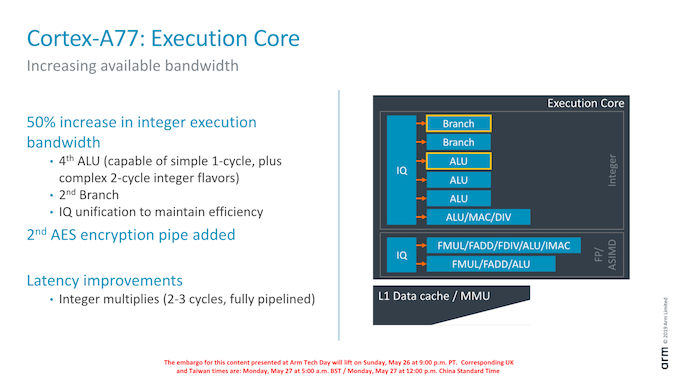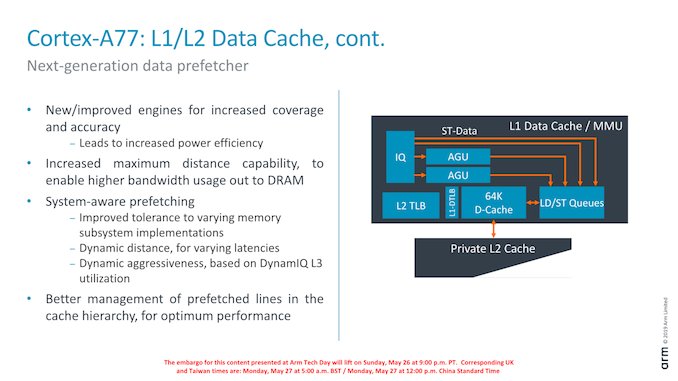Arm's New Cortex-A77 CPU Micro-architecture: Evolving Performance
by Andrei Frumusanu on May 27, 2019 12:01 AM ESTThe Cortex-A77 µarch: Added ALUs & Better Load/Stores
Having covered the front-end and middle-core, we move onto the back-end of the Cortex-A77 and investigate what kind of changes Arm has made to the execution units and data pipelines.
On the integer execution side of the core we’ve seen the addition of a second branch port, which goes along with the doubling of the branch-predictor bandwidth of the front-end.
We also see the addition on an additional integer ALU. This new unit goes half-way between a simple single-cycle ALU and the existing complex ALU pipeline: It naturally still has the ability of single-cycle ALU operations but also is able to support the more complex 2-cycle operations (Some shift combination instructions, logical instructions, move instructions, test/compare instructions). Arm says that the addition of this new pipeline saw a surprising amount of performance uplift: As the core gets wider, the back-end can become a bottleneck and this was a case of the execution units needing to grow along with the rest of the core.
A larger change in the execution core was the unification of the issue queues. Arm explains that this was done in order to maintain efficiency of the core with the added execution ports.
Finally, existing execution pipelines haven’t seen much changes. One latency improvement was the pipelining of the integer multiply unit on the complex ALU which allows it to achieve 2-3 cycle multiplications as opposed to 4.
Oddly enough, Arm didn’t make much mention of the floating-point / ASIMD pipelines for the Cortex-A77. Here it seems the A76’s “state-of-the-art” design was good enough for them to focus the efforts elsewhere on the core for this generation.
On the part of the load/store units, we still find two units, however Arm has added two additional dedicated store ports to the units, which in effect doubles the issue bandwidth. In effect this means the L/S units are 4-wide with 2 address generation µOps and 2 store data µOps.
The issue queues themselves again have been unified and Arm has increased the capacity by 25% in order to expose more memory-level parallelism.
Data prefetching is incredibly important in order to hide memory latency of a system: Shaving off cycles by avoiding to having to wait for data can be a big performance boost. I tried to cover the Cortex-A76’s new prefetchers and contrast it against other CPUs in the industry in our review of the Galaxy S10. What stood out for Arm is that the A76’s new prefetchers were outstandingly performant and were able to deal with some very complex patterns. In fact the A76 did far better than any other tested microarchitecture, which is quite a feat.
For the A77, Arm improved the prefetchers and added in even new additional prefetching engines to improve this even further. Arm is quite tight-lipped about the details here, but we’re promised increased pattern coverages and better prefetching accuracy. One such change is claimed to be “increased maximum distance”, which means the prefetchers will recognize repeated access patterns over larger virtual memory distances.
One new functional addition in the A77 is so called “system-aware prefetching”. Here Arm is trying to solve the issue of having to use a single IP in loads of different systems; some systems might have better or worse memory characteristics such as latency than others. In order to deal with this variance between memory subsystems, the new prefetchers will change the behaviour and aggressiveness based on how the current system is behaving.
A thought of mine would be that this could signify some interesting performance improvements under some DVFS conditions – where the prefetchers will alter their behaviour based on the current memory frequency.
Another aspect of this new system-awareness is more knowledge of the cache pressure of the DSU’s L3 cache. In case that other CPU cores would be highly active, the core’s prefetchers would see this and scale down its aggressiveness in order to possibly avoid thrashing the shared cache needlessly, increasing overall system performance.













108 Comments
View All Comments
Thala - Monday, May 27, 2019 - link
An "A77 7nm SoC" would consist of 4 A77 cores, while "10nm A10" consists of 2 high performance Fusion cores - making the A77 SoC much faster than A10.You cannot use single core performance to reason about SoC performance without taking the number of cores into consideration.
LiverpoolFC5903 - Tuesday, May 28, 2019 - link
I wonder why do people make these pointless comparisons. You have an OS that doesn't allow you to do half the things you can do on an Android system, so what exactly is the use of a super high powered soc?Can you copy music and movies directly into your flash memory?
Can you attach external memory using OTG?
Can you use USB OTG peripherals like gamepads and keyboards?
Can you install apps/software from outside of Apple's closed ecosystem?
Can you get pointer support in iOS?
Can you properly manage the files in your smartphone?
Can your iphone seamlessly interface with your windows PC?
Phynaz - Thursday, May 30, 2019 - link
Did you know it’s 2019? 2007 wants their Apple hate back.Valis - Thursday, May 30, 2019 - link
And 2007 wants its limited OS back. Not to mention the price for 720p devices.Meteor2 - Monday, June 3, 2019 - link
It's 2019, and iOS is still as restricted as it ever was.jjj - Monday, May 27, 2019 - link
Will be interesting to see cloud providers adopting the server version. It's small,it's efficient, it's pretty fast, should be good business.Meteor2 - Monday, June 3, 2019 - link
Server CPUs seem to take a lot longer to reach market; it's still only A72 and A73 stuff at the moment! Much less money for the necessary investment. But when A76 and A77 does reach the server (and maybe the desktop?) it's going to be very exciting.Demaniax - Monday, May 27, 2019 - link
Can anyone tell me how to learn all of these things ? I mean how does a CPU made. What is a Pipeline ? What is branch prediction ? And all those things. I want to learn everything. But How ? Is there any online course ?frenchy_2001 - Monday, May 27, 2019 - link
http://lmgtfy.com/?q=cpu+design+class+free+onlinethe links to edx and saylor.org would be interesting.
It all depends on what your background is and how serious you are.
You can find great resources online, but this is a big and very advanced domain, so you may need to follow intro level classes in digital circuits before being able to follow full architecture.
suvtab - Tuesday, May 28, 2019 - link
A book on Computer Architecture (https://en.wikipedia.org/wiki/Computer_architectur... will be a good start point. I personally recommend David Patterson's classical textbook "Computer Architecture: A Quantitative Approach".